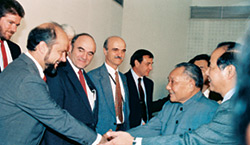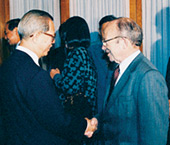Physicists witness a changing China
China gave the year a haunting label: "Curse of 1976." The Premier of the Peoples Republic, Zhou Enlai, died in early January. Chinese Red Army founder and elder statesmen Zhu De died in early July. Chairman Mao Zedong died in September, prompting the bloody power grab by The Gang of Four. And on July 28, an earthquake estimated at magnitude 8.0 struck the industrial city of Tangshan, about 95 miles from Beijing, followed by a magnitude 7.1 aftershock. The official death toll was more than 240,000; unofficial estimates surpassed 600,000 dead and more than 750,000 injured.
This was the scarred and battered China that met SLAC director W.H.K. "Pief" Panofsky on his first visit in late summer of 1976–just four years after the historic visit of US President Richard Nixon. Panofsky made his journey by invitation of Chang Wu-yen, to discuss possibilities for China embarking on a high-energy physics program. "I assumed that my trip would be canceled," Panofsky says, "but Chang prevailed that it should go forward despite the fact that many buildings in Beijing had been condemned as unsafe, and people were living in the streets in tents erected by the army."
 |
 |
|
Pier Oddone (left photo) exchanges greetings with Premier Deng Xiaoping while visiting China in 1988 with the PRC-US Committee. |
|
|
Pief Panofsky (right photo) confers with Peoples Republic Science Minister Fang Yi in this image from the IHEP-Beijing website commemorating the 25th anniversary of the PRC-US Committee. |
|
|
Photos courtesy of IHEP-Beijing |
|
Panofsky saw a people deter-mined to move on. "Regular life was disrupted by the earthquake," he recalls, "but I was impressed by the flood of bicycles, by the general resourcefulness of people ‘to cope,' and by the insistence of some of the Chinese scientists to go forward in pursuing HEP." Through Chang, Panofsky met with scientists and government officials to consider their approach. "We discussed alternatives," he says. "At that time, the Chinese had planned to build a proton machine near the Ming tombs [about 30 miles from Beijing]. As a result of my raising questions as to this approach, Fang Yi, the Chinese Science Minister, visited the US, including Fermilab. This resulted finally in the Chinese decision to build the [Beijing Electron Positron Collider]."
Thus, Panofsky was an active participant in HEP collaboration between the two countries even before the official PRC-US Committee was formed in 1979 by President Jimmy Carter and Premier Deng Xiaoping. Panofsky credits SLAC and Fermilab, especially Fermilab Director Robert Wilson, with boosting China in its initial high-energy physics efforts. He recalls: "Bob Wilson, after extensive soul searching on the subject, agreed that it would be best for China to build an electron-positron colliding beam machine as an initial entry into HEP."
Panofsky has been a member of the PRC-US Committee since its inception. Among many other colleagues, he was joined in 1986 by Berkeley Lab Physics Division director Pier Oddone, who is now the director of Fermilab. Through their visits over the ensuing decades, they have seen changes that they find amazing even while watching them happen. "There has been a tremendous transformation," Oddone says. "The streets were once filled with bicycles, and now they are filled with cars. The economy has grown 10 percent a year for 20 years."
Asked what has changed the most, Panofsky says: "My answer is: almost everything. There is vast migration of people from the countryside to the cities, the ruthless tearing down of old buildings in the cities to make room for high rises to accommodate the influx, the displacement of bicycle traffic by automobiles, and the dramatic rate of construction of roads to accommodate that traffic. But mainly, people talk much more freely."
Chinese colleagues apparently speak freely and respectfully of Panofsky, conferring on him the title, "Lao Pan." Panofsky explains: "‘Lao Pan' means something like ‘Good Old Pan' or ‘The Elder Pan.' ‘Lao' is a title without American English equivalent, denoting both a form of address, such as ‘Mr.' and also one who is something of a respected patriarch."
Mike Perricone
Click here to download the pdf version of this article.






